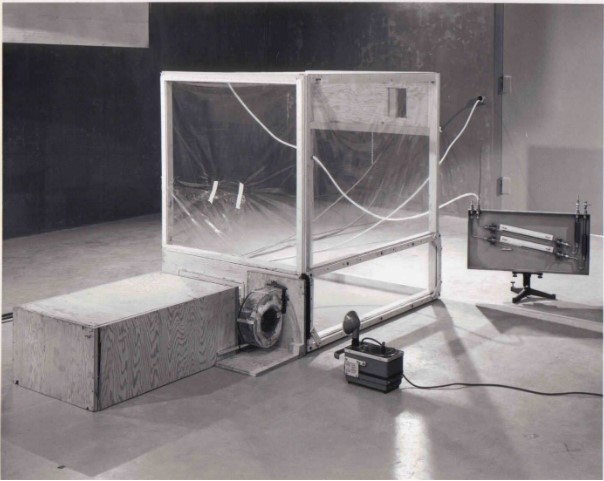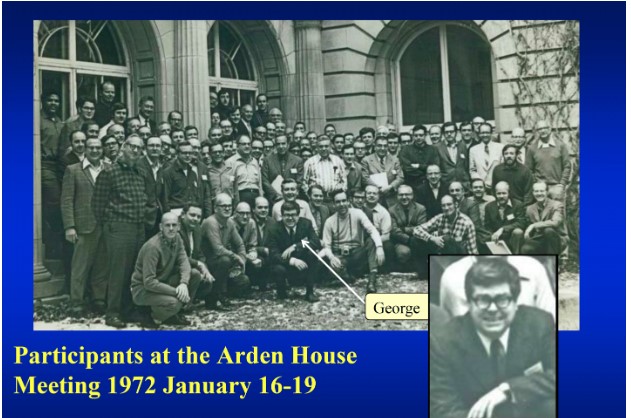A Tribute to George Maling
The passing of George Maling has been causing reflection and examination of George’s many
contributions to INCE-USA, I-INCE, and the field of noise control. His contributions are particularly important for readers of this magazine, as it would probably not exist without him! He was a founding member of the INCE-USA in 1971, I-INCE in 1974, and eventually the NNI magazine.
At Noise-Con 2014, INCE-USA held a special session to honor the many contributions George made to the noise control engineering profession. What follows are some excerpts of what was presented at that session.
About George Maling (Excerpt from opening remarks by Bill Lang)
George entered the field in 1954 as a graduate student; and in 1963, when he completed his Ph.D.
under Uno Ingard, he had five academic degrees—four from MIT and his Bachelor’s degree
from Bowdoin College. After consulting for IBM for several years, he became a full-timer in 1965 and was the specialist for the corporation available to consult on problems related to product noise control on all four continents. But his duties were principally directed at the design and product development of low-noise business machines for the Poughkeepsie acoustics laboratory.
My first example of his corporate responsibilities was when he was called to an IBM plant in New Jersey manufacturing punch cards for the IT industry. OSHA inspectors found the twenty card manufacturing presses to be over the OSHA noise limit for operator exposure and threatened to close down the plant until a plan was in place for reducing the operator exposure. The local management told George that two years previous they were working on this problem, and had a noise enclosure for each press designed, but the operators had them removed as they were interfering with card production. The covers were scrapped. George told management to find one. After a mad scramble, a scrap cover was located on a farmer’s field in Indiana; and IBM had it shipped back to New Jersey. The problem with reinstalling the cover was that the farmer had used it as a chicken coop, and it was full of chicken poop. But the plant was rescued from closing when George had the chicken poop removed, the cover re-installed on one press, and the OSHA inspector approved his plan to lower the noise levels of all the presses in the New Jersey card plant. The day was saved with the best analog equipment available in 1967.
There was not much signal processing in this field trip, but George’s interest in signal processing was developing, but it was in its infancy. How primitive it was illustrated by a request by the IBM Executive Vice President for Innovation to demonstrate to the IBM Board of Directors how the field was developing. George, with two engineers and a station wagon full of the best analog equipment available in 1967, was told he could set up the demonstration in the Board room starting at 5 p.m. for the next day’s Board meeting. He worked all night to set up the demonstration with local difficulties, there was not even a 110-volt AC outlet in the room. The demo consisted of an IBM type-bar typewriter at one end of the room and a large meter at the other end of the room with three areas marked. The left sector was marked with a capital I, the middle sector with a Capital B, and the right sector with a capital M. With the best analog equipment and microphone in front of the meter, the operator would type an I and the needle on the meter would swing up to the I sector; with B it would swing up to B, and with M it would swing up to M, all without wires and the rudiments of signal processing. After working all night and getting the demonstration to work flawlessly by 7 a.m., George was confronted at 8 a.m. by the IBM Vice President in charge of arranging the Board meeting for the IBM directors that would convene at 9 a.m. a.m. “What’s all this stuff?” he asked George. “It’s a demo for the Board requested to be set up by the Executive Vice President for Innovation.” Without even bothering to look at the demonstration, the IBM VP coordinating the meeting told George that the Board members would be unable to understand the demonstration and told him to get it out of there. By 9 a.m. the room was clean, and George and his helpers had all the equipment back in the station wagon headed back to Poughkeepsie.
But George’s interest in signal processing and the impending evolution of digital signal processing was undismayed. He struck up a friendship with Jim Cooley, an IBM researcher who had developed an algorithm for digital signal processing with John Tukey of Bell Telephone Laboratories. George immediately grasped that this algorithm might be what was needed to move the world from analog signal processing to digital signal processing. Working with Jim and other collaborators from BTL and MIT, he organized two symposia on the algorithm—one held in New York by the IEEE and the second in Boston by the ASA. By the end of 1967, the algorithm had caught fire, not only for the processing of noise signals but for all electronic signals transmitted through the air or on wires. IEEE top management was astounded at this development and requested that George and his collaborators immediately prepare a paper for the proceedings of the IEEE entitled “What is the Fast Fourier Transform?” Every electronic device on your desk or in your pocket today incorporates the FFT or its modern equivalent. What started out as a new technique for processing the noises audible to the ear in digital format was responsible for the explosion of interest in the FFT which has had the inestimable benefit to the world.

An example of one (of many) significant contribution to the Field (Excerpt from a presentation from Matt Nobile)
The need for a fixture to test air moving devices was recognized many years ago in the Information Technology industry.
In the early 1960s, George Maling and his associates at IBM developed a plenum for the testing of such devices. Details of the plenum design were revealed to the technical community via a special session on “Measurement of Noise from Fans for Cooling Electronics” at the Internoise 1982 Conference. Then, through the efforts of the INCE Technical Committee on Information Technology Equipment Noise Emissions, the plenum was eventually standardized in ANSI S12.114 and ISO 10302. Within the technical community, it has become known as the “Maling Box”.


which can even be fully automated. And for this, we owe it all to George!
The Glue that held INCE-USA Together (Excerpt from presentation by Joe Cuschieri)
For his presentation, Joe Cuschieri began his talk with a summary of the personal notes of Bill Lang who offered an informal account of the early years of INCE-USA. Here it is noted that George Maling “provided the glue that has held the organization (INCE/USA) together”. And in addition to serving as INCE Secretary, INCE President, and General Chairman of INTER-NOISE 80 and 89, George served continuously as Editor-in-Chief of NOISE/NEWS since he published the first issue in 1972. The very first publication (Issue No. 1) of NOISE/NEWS dated 1972 January-February, featured a photo of Leo Beranek on the cover, and a lead article that was titled “INCE is Incorporated”. It included photos from the ASA Conference on Noise Standards which had been held at Arden House during the period 1971 July 28-31.

George and Noise News International (Excerpt from George’s Personal history of NNI and I-INCE (1))
In 1971, the Institute of Noise Control Engineering (INCE-USA) was incorporated after many meetings and discussions on the need for a professional organization devoted to noise control engineering. In January of 1971, a group of American professionals met at Arden House in Harriman, New York, USA to discuss the formation of a new professional organization. It was voted to proceed with the founding of what was to become INCE/USA. The incorporation took place in June, and the first meeting of an interim Board of Directors was held in October. The organization needed some sort of publication, and I volunteered to produce a newsletter, which I named Noise/News. The newsletter was to be published bimonthly, and the first issue was dated January-February, 1972. Noise/News was distributed at a January 1972 organizational meeting of INCE/USA at Arden House, and we offered annual subscriptions. I remember returning from Arden House with nine subscribers! As will be seen, Noise/News was one of the predecessors of Noise/News International
At the October meeting mentioned above, it was agreed that an international conference should be held in 12 months, and, as the suggestion of my long-time challenges, Dr. William (Bill) Lang, it was called INTER-NOISE. The first meeting was in Washington D.C, USA was organized by Professor Malcolm Crocker as General Chair, and was quite successful. The founders of INCE/USA had a vision of an international organization that would consist of acoustical societies and institutes of noise control engineering. Professor Fritz Ingerslev announced the formation of International INCE at the end of the opening plenary session of INTER-NOISE 74 in Washington, D.C., USA on September 30, 1974.
Shortly after the founding of I-INCE, it was recognized that the organization also needed the means to communicate, and Eric Rathé volunteered to be the editor of the International INCE Newsletter. I worked with him and supplied information of international interest from the INCE/USA publication, Noise/News.
In 1992, Bill Lang and I attended INTER-NOISE 92, which was held in Toronto, Canada. The technical publication of INCE/USA, Noise Control Engineering Journal (NCEJ), edited by Professor Crocker was, thanks to his dedicated efforts for almost 20 years, a very successful technical publication, but was having difficulty attracting advertisers. This problem was recognized by the INCE/USA Board of Directors, but no action was agreed upon. After the meeting, Bill Lang and I discussed the situation, and we concluded that it would be of benefit to both International INCE and INCE/USA to combine Noise/News and the International INCE Newsletter, and to launch a new publication.
This is how Noise/News International came about, and the first issue was published in March 1993.

[1] George C. Maling Jr., A Personal History of Noise/News International and International INCE, The Journal of the INCE of Japan, 2004, Volume 28, Issue 6, Pages 383-386.



